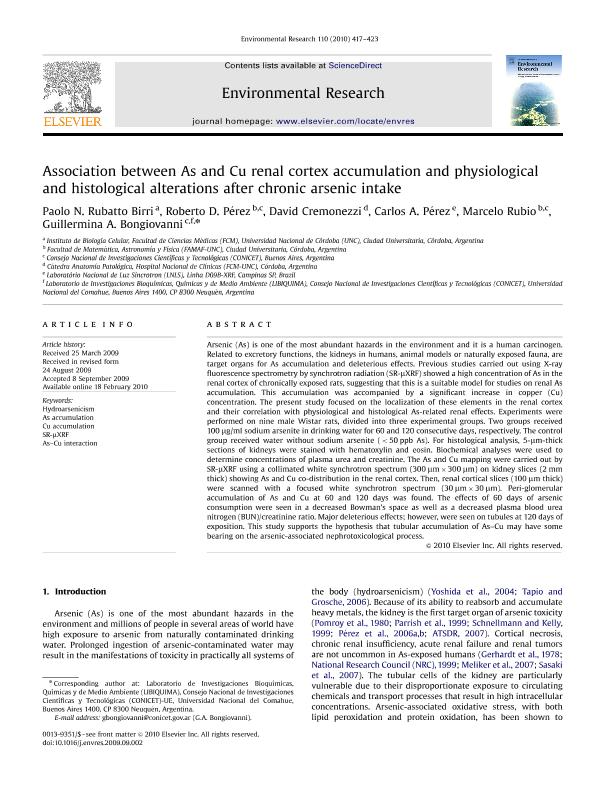Mostrar el registro sencillo del ítem
dc.contributor.author
Rubatto Birri, Paolo Nahuel

dc.contributor.author
Perez, Roberto Daniel

dc.contributor.author
Cremonezzi, David César

dc.contributor.author
Pérez, Carlos A.
dc.contributor.author
Rubio, Marcelo Enrique

dc.contributor.author
Bongiovanni, Guillermina Azucena

dc.date.available
2023-02-22T12:22:41Z
dc.date.issued
2010-07
dc.identifier.citation
Rubatto Birri, Paolo Nahuel; Perez, Roberto Daniel; Cremonezzi, David César; Pérez, Carlos A.; Rubio, Marcelo Enrique; et al.; Association between As and Cu renal cortex accumulation and physiological and histological alterations after chronic arsenic intake; Academic Press Inc Elsevier Science; Environmental Research; 110; 5; 7-2010; 417-423
dc.identifier.issn
0013-9351
dc.identifier.uri
http://hdl.handle.net/11336/188527
dc.description.abstract
Arsenic (As) is one of the most abundant hazards in the environment and it is a human carcinogen. Related to excretory functions, the kidneys in humans, animal models or naturally exposed fauna, are target organs for As accumulation and deleterious effects. Previous studies carried out using X-ray fluorescence spectrometry by synchrotron radiation (SR-μXRF) showed a high concentration of As in the renal cortex of chronically exposed rats, suggesting that this is a suitable model for studies on renal As accumulation. This accumulation was accompanied by a significant increase in copper (Cu) concentration. The present study focused on the localization of these elements in the renal cortex and their correlation with physiological and histological As-related renal effects. Experiments were performed on nine male Wistar rats, divided into three experimental groups. Two groups received 100 μg/ml sodium arsenite in drinking water for 60 and 120 consecutive days, respectively. The control group received water without sodium arsenite (<50. ppb As). For histological analysis, 5-μm-thick sections of kidneys were stained with hematoxylin and eosin. Biochemical analyses were used to determine concentrations of plasma urea and creatinine. The As and Cu mapping were carried out by SR-μXRF using a collimated white synchrotron spectrum (300 μm×300 μm) on kidney slices (2. mm thick) showing As and Cu co-distribution in the renal cortex. Then, renal cortical slices (100 μm thick) were scanned with a focused white synchrotron spectrum (30 μm×30 μm). Peri-glomerular accumulation of As and Cu at 60 and 120 days was found. The effects of 60 days of arsenic consumption were seen in a decreased Bowman's space as well as a decreased plasma blood urea nitrogen (BUN)/creatinine ratio. Major deleterious effects; however, were seen on tubules at 120 days of exposition. This study supports the hypothesis that tubular accumulation of As-Cu may have some bearing on the arsenic-associated nephrotoxicological process.
dc.format
application/pdf
dc.language.iso
eng
dc.publisher
Academic Press Inc Elsevier Science

dc.rights
info:eu-repo/semantics/openAccess
dc.rights.uri
https://creativecommons.org/licenses/by-nc-sa/2.5/ar/
dc.subject
AS ACCUMULATION
dc.subject
AS-CU INTERACTION
dc.subject
CU ACCUMULATION
dc.subject
HYDROARSENICISM
dc.subject
SR-ΜXRF
dc.subject.classification
Salud Pública y Medioambiental

dc.subject.classification
Ciencias de la Salud

dc.subject.classification
CIENCIAS MÉDICAS Y DE LA SALUD

dc.title
Association between As and Cu renal cortex accumulation and physiological and histological alterations after chronic arsenic intake
dc.type
info:eu-repo/semantics/article
dc.type
info:ar-repo/semantics/artículo
dc.type
info:eu-repo/semantics/publishedVersion
dc.date.updated
2023-02-02T23:14:35Z
dc.journal.volume
110
dc.journal.number
5
dc.journal.pagination
417-423
dc.journal.pais
Estados Unidos

dc.description.fil
Fil: Rubatto Birri, Paolo Nahuel. Universidad Nacional de Córdoba. Facultad de Medicina; Argentina
dc.description.fil
Fil: Perez, Roberto Daniel. Consejo Nacional de Investigaciones Científicas y Técnicas. Centro Científico Tecnológico Conicet - Córdoba. Instituto de Física Enrique Gaviola. Universidad Nacional de Córdoba. Instituto de Física Enrique Gaviola; Argentina
dc.description.fil
Fil: Cremonezzi, David César. Universidad Nacional de Córdoba. Facultad de Medicina; Argentina
dc.description.fil
Fil: Pérez, Carlos A.. No especifíca;
dc.description.fil
Fil: Rubio, Marcelo Enrique. Consejo Nacional de Investigaciones Científicas y Técnicas. Centro Científico Tecnológico Conicet - Córdoba. Instituto de Física Enrique Gaviola. Universidad Nacional de Córdoba. Instituto de Física Enrique Gaviola; Argentina
dc.description.fil
Fil: Bongiovanni, Guillermina Azucena. Universidad Nacional del Comahue. Facultad de Ingeniería. Departamento de Química. Laboratorio de Investigaciones Bioquímicas, Químicas y de Medio Ambiente; Argentina. Consejo Nacional de Investigaciones Científicas y Técnicas; Argentina
dc.journal.title
Environmental Research

dc.relation.alternativeid
info:eu-repo/semantics/altIdentifier/url/https://www.sciencedirect.com/science/article/abs/pii/S0013935109001704
dc.relation.alternativeid
info:eu-repo/semantics/altIdentifier/doi/http://dx.doi.org/10.1016/j.envres.2009.09.002
Archivos asociados
